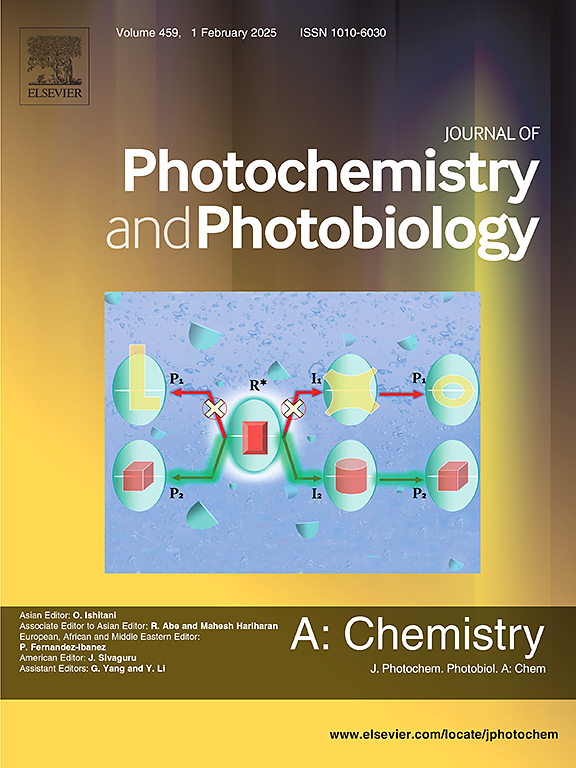Ring strain integrity in the absorption spectrum of β-propiolactone: VUV spectroscopy in the photon energy 4.6–10.8 eV
IF 4.7
3区 化学
Q2 CHEMISTRY, PHYSICAL
Journal of Photochemistry and Photobiology A-chemistry
Pub Date : 2025-06-11
DOI:10.1016/j.jphotochem.2025.116573
引用次数: 0
Abstract
New absolute cross-section values are reported from high-resolution vacuum ultraviolet (VUV) photoabsorption measurements of β-propiolactone in the photon energy range 4.6–10.8 eV (268–115 nm). The assignment of the different vibronic features has been performed with the aid of quantum chemical calculations that provide vertical energies, oscillator strengths and harmonic frequencies. The joint experimental and theoretical methodology employed provides a comprehensive review of the electronic state spectroscopy of CH2CH2CO2. A photoelectron spectrum has also been recorded from 10 up to 24 eV and compared to earlier data in the literature. A new value of (10.560 ± 0.002) eV for the ground ionic state adiabatic ionisation energy is recommended. The vibrational features in the spectral bands are assigned to C=O stretching, , CH2 wagging, , ring C–O stretching, , and C=O in-plane bending, modes. Potential energy curves for the lowest-lying electronic excited states, as a function of the C–O/C=O coordinates, have been obtained from time-dependent density functional theory (TD-DFT). Ring strain integrity is shown to be a fragile mechanism upon electronic excitation. The calculations have also shed light on the relevant internal conversion from the electronic excited states governing the nuclear dynamics with significant pre-dissociative character of the lowest-lying electronic states.

β-丙内酯吸收光谱中的环应变完整性:光子能量4.6-10.8 eV的VUV光谱
利用高分辨率真空紫外(VUV)在光子能量范围4.6 ~ 10.8 eV (268 ~ 115 nm)内测量了β-丙内酯的绝对截面值。在量子化学计算的帮助下,完成了不同振动特征的分配,这些计算提供了垂直能量、振子强度和谐波频率。采用实验和理论相结合的方法对CH2CH2CO2的电子态光谱进行了全面的评述。光电子谱也记录了从10到24 eV,并与文献中早期的数据进行了比较。建议采用(10.560±0.002)eV作为基态绝热电离能的新值。光谱波段的振动特征归属于C=O拉伸,v3a ‘, CH2摆动,v6’a ‘,环C - O拉伸,v10’a ‘和C=O面内弯曲,v13’a '模式。本文利用时变密度泛函理论(TD-DFT),得到了最底层电子激发态的势能随C - O/C=O坐标的变化曲线。在电子激励下,环应变完整性是一种脆弱的机制。计算还揭示了从控制核动力学的电子激发态的相关内部转换,具有最低电子态的显著预解离特征。
本文章由计算机程序翻译,如有差异,请以英文原文为准。
求助全文
约1分钟内获得全文
求助全文
来源期刊
CiteScore
7.90
自引率
7.00%
发文量
580
审稿时长
48 days
期刊介绍:
JPPA publishes the results of fundamental studies on all aspects of chemical phenomena induced by interactions between light and molecules/matter of all kinds.
All systems capable of being described at the molecular or integrated multimolecular level are appropriate for the journal. This includes all molecular chemical species as well as biomolecular, supramolecular, polymer and other macromolecular systems, as well as solid state photochemistry. In addition, the journal publishes studies of semiconductor and other photoactive organic and inorganic materials, photocatalysis (organic, inorganic, supramolecular and superconductor).
The scope includes condensed and gas phase photochemistry, as well as synchrotron radiation chemistry. A broad range of processes and techniques in photochemistry are covered such as light induced energy, electron and proton transfer; nonlinear photochemical behavior; mechanistic investigation of photochemical reactions and identification of the products of photochemical reactions; quantum yield determinations and measurements of rate constants for primary and secondary photochemical processes; steady-state and time-resolved emission, ultrafast spectroscopic methods, single molecule spectroscopy, time resolved X-ray diffraction, luminescence microscopy, and scattering spectroscopy applied to photochemistry. Papers in emerging and applied areas such as luminescent sensors, electroluminescence, solar energy conversion, atmospheric photochemistry, environmental remediation, and related photocatalytic chemistry are also welcome.

 求助内容:
求助内容: 应助结果提醒方式:
应助结果提醒方式:


